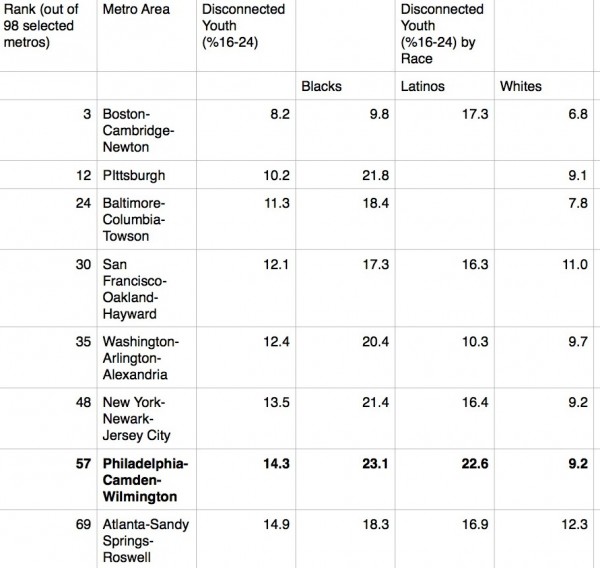107,000 Teens and Young Adults With Nothing to Do
Nearly 20 percent of Philadelphians aged 16-24 are neither enrolled in school or working. That’s about 46,000 teens and young adults with not a lot to do. That’s a troublingly high number, reported by Philadelphia Works earlier this year. Now comes worse news: in comparison to other metro areas nationwide, the Philadelphia region does a really rotten job keeping older teens and young adults employed and enrolled.
According to a new study from Measure of America, a project by the Social Science Research Council, Philadelphia has the highest proportion of “disconnected” youths of any big metro in the Northeast. More than 107,000 young adults in the metro area are unemployed and not enrolled in school.

Source: Data from “Zeroing in on Race and Place”
And the racial disparities are huge. Among that age group, about 23 percent of Blacks and Latinos are not working or enrolled in school. Among whites, that number is only nine percent. The 14-point disparity locally is significantly larger than the nationwide gap of 10 percent between whites and blacks and the five percent gap between whites and Latinos.
Nationwide, the study shows there are 5.5 million youths between the ages of 16 and 24 neither working nor in school. Interestingly, the study finds that high levels of youth “disconnected”-ness correlates most strongly not with high poverty rates or high unemployment, but with segregation:
… previous Measure of America research has shown the greatest gaps of all are between overwhelmingly white and overwhelmingly black neighborhoods within metro areas; in greater Chicago, Washington, DC, and Philadelphia, at least ten times as many young people living in a few predominately black neighborhoods were disconnected as youth living in a few nearly all-white neighborhoods.
The study also illuminates the devastating effects of youth disconnection on a broader, systemic scale:
the negative effects of youth disconnection ricochet across the economy, the social sector, the criminal justice system, and the political landscape, affecting all of us. Our analysis of a very small subset of the direct costs of youth disconnection reveals an astonishingly high cost to taxpayers: $26.8 billion in 2013 alone, or nearly the entire amount the federal government spends on science.
Who knows how much taxpayers are paying locally. But it’s no doubt a ton. And we don’t fix our school system and provide avenues for youth employment, we’ll continue to pay for it as a city.

